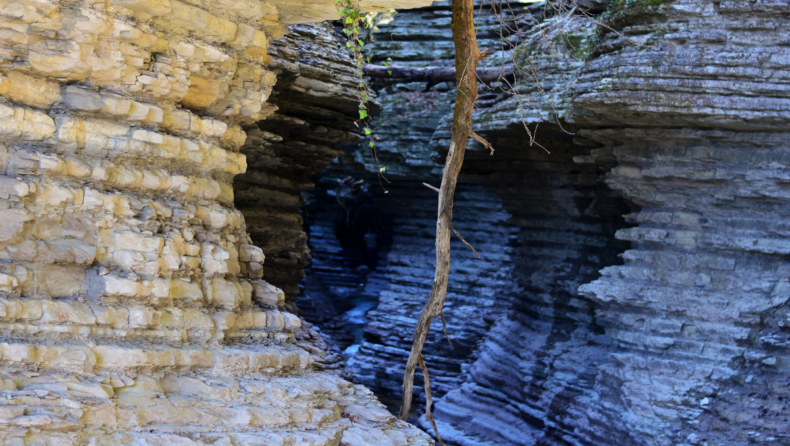
Common ancestor genome reconstructions have discovered hydrogen peroxide and oxygen cycling genes. People usually think that hydrogen peroxide and oxygen on the early Earth came from lateral gene transfer after oxygenic photosynthesis developed.
The ground-breaking research effort, which was directed by the School of Natural and Environmental Sciences at Newcastle University and reported in Nature Communications, discovered a mechanism that can create hydrogen peroxide from rocks during the movement of geological faults.
Another possibility is that hydrogen peroxide and oxygen came from rocks on the early Earth.
Scientists show that when faults in crushed silicate rocks are filled with water and heated to temperatures close to boiling, a lot of hydrogen peroxide is released even when there is no oxygen around. However, extremely less hydrogen peroxide is released at temperatures below 80°C.
Near the base of the Universal Tree of Life, this temperature range is where heat-loving and oxygen-breathing Bacteria and Archaea lived and grew in the past.
The Researchers
The researchers hypothesize that thermal activation of mineral surface flaws during geological fault movements and accompanying pressures in the Earth’s crust drove the geochemistry of hot fractures where life first originated.
It is not just earthquakes that are generated when the Earth’s crust moves, but also the subsurface, which is coated with highly reactive rock surfaces that include many irregularities or cracks when the Earth’s crust moves. Water can filter down and react with rock faults.
In the lab, a student replicated early Earth’s conditions by breaking granite, basalt, and peridotite. These were introduced to oxygen-free water at different temperatures.

What do Researchers say?
Dr Jon Telling, Senior Lecturer, said this research indicates that cracks on crushed rock and minerals behave differently than ‘perfect’ mineral surfaces.
It is possible that these mechanochemical reactions could have altered the chemistry and microbiology of the early Earth in hot, seismically active places where life may have first originated, as water, crushed rocks, and high temperatures were all present on the early Earth before the emergence of photosynthesis.
Dr Jordan Stone, lead author of the study added that,
“While previous research has suggested that small amounts of hydrogen peroxide and other oxidants can be formed by stressing or crushing of rocks in the absence of oxygen, this is the first study to show the vital importance of hot temperatures in maximizing hydrogen peroxide generation.”
Newcastle University researchers have found an oxygen source that may have affected life before photosynthesis.
The ground-breaking research effort, which was directed by the School of Natural and Environmental Sciences at Newcastle University and reported in Nature Communications, discovered a mechanism that can create hydrogen peroxide from rocks during the movement of geological faults.

Overview
Common ancestor genome reconstructions have discovered hydrogen peroxide and oxygen cycling genes. People usually think that hydrogen peroxide and oxygen on the early Earth came from lateral gene transfer after oxygenic photosynthesis developed.
Another possibility is that hydrogen peroxide and oxygen came from rocks on the early Earth.
Scientists show that when faults in crushed silicate rocks are filled with water and heated to temperatures close to boiling, a lot of hydrogen peroxide is released even when there is no oxygen around. However, extremely less hydrogen peroxide is released at temperatures below 80°C.
Near the base of the Universal Tree of Life, this temperature range is where heat-loving and oxygen-breathing Bacteria and Archaea lived and grew in the past.
The Researchers
The researchers hypothesize that thermal activation of mineral surface flaws during geological fault movements and accompanying pressures in the Earth’s crust drove the geochemistry of hot fractures where life first originated.
It is not just earthquakes that are generated when the Earth’s crust moves, but also the subsurface. The subsurface is coated with highly reactive rock surfaces that include many irregularities or cracks when the Earth’s crust moves. Water can filter down and react with rock faults.
In the lab, a student replicated early Earth’s conditions by breaking granite, basalt, and peridotite. These were introduced to oxygen-free water at different temperatures.
What do Researchers say?
Dr Jon Telling, Senior Lecturer, said this research indicates that cracks on crushed rock and minerals behave differently than ‘perfect’ mineral surfaces.
It is possible that these mechanochemical reactions could have altered the chemistry and microbiology of the early Earth in hot, seismically active places where life may have first originated. Water, crushed rocks, and high temperatures were all present on the early Earth before the emergence of photosynthesis.
Dr Jordan Stone, lead author of the study added that,
“While previous research has suggested that small amounts of hydrogen peroxide and other oxidants can be formed by stressing or crushing of rocks in the absence of oxygen, this is the first study to show the vital importance of hot temperatures in maximizing hydrogen peroxide generation.”
Conclusion
Hydrogen peroxide can be dangerous to life in large amounts, but it can also be used by microbes to get oxygen. Before photosynthesis was invented, this extra source of oxygen may have affected the early development and even the beginning of life in hot places on the early Earth.
Hydrogen peroxide can be dangerous to life in large amounts, but it can also be used by microbes to get oxygen. Before photosynthesis was invented, this extra source of oxygen may have affected the early development and even the beginning of life in hot places on the early Earth.













